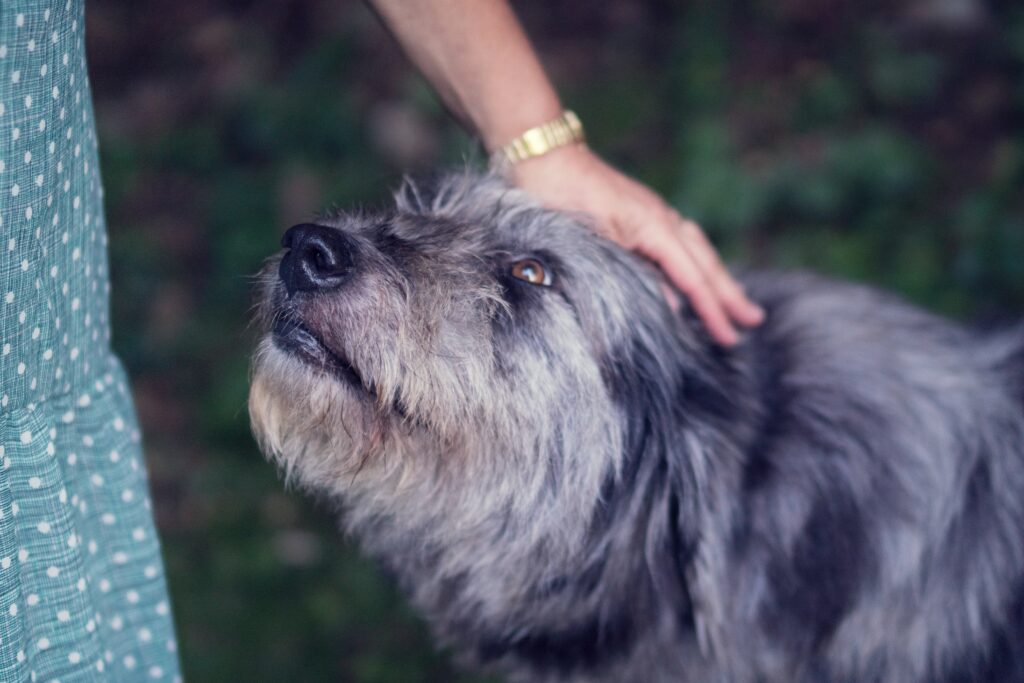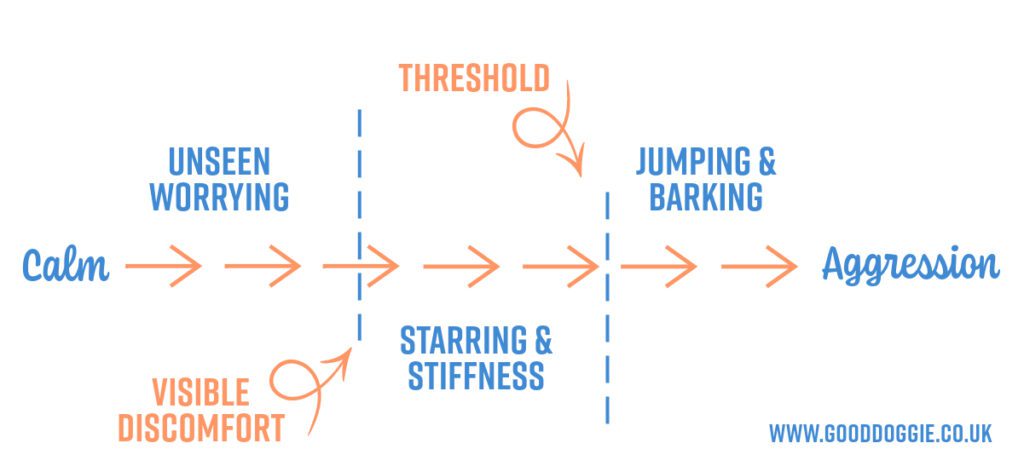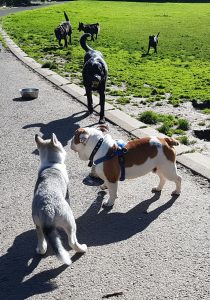Get an awesome recall. Join my 30 day, step by step program now...
Dog behaviours you can’t see, and what to do about them
In the world of dog behaviour it is easy to focus on the unwanted behaviour we can see. After all its stuff like barking, cowering, lunging, or pulling that we want to stop. But there are other kinds of dog behaviours you can’t see. Here’s why they are important and what to do about them!
Going over threshold
When your dog is over threshold he has become overwhelmed by an emotion. Whether that emotion is excitement, fear, sadness, or anger, he is no longer in control. His reactive brain has taken over and he is not making sensible decisions anymore. So this behaviour is big and obvious. This is usually the stuff we want to change. This is the pulling, lunging, crying and the growling type behaviour that push people to seek help for their dog.
These behaviours are difficult because when a dog gets to this level of overwhelm they are very difficult to distract, and they often don’t respond to cues either. They stop responding to their favourite rewards and toys too. So, when you approach a problem like this, it is frustrating work for little benefit. And this can be what pushes people to try more forceful methods in an effort to be heard and relieve that frustration. There are problems with this, but luckily there is a better way…
How can I help you with your dogs behaviour training?
Private Dog Behaviour Consultations are currently available online and in-person in Dundee and the surrounding area. If you are looking for help solving your dogs behaviour and training problems, please get in touch!
Out of his comfort zone
This type of behaviour precedes going over threshold. In this zone, the dog is aware of a problem or trigger and has started to change their behaviour. This behaviour is much more subtle and could look like stiffness in the body, avoiding contact, making himself look taller, fixing a stare or maybe a twitchy tail. Very few people report these behaviours to me when they are seeking help, but they are just as important as the big behaviours we see when the dog goes over threshold.
These subtle behaviours are exactly what I tell people to look for when they are working with their dog as this is the perfect time to intervene. At this level, the dog is still thinking and listening, and will still respond to you if you ask for a well-known cue or call their name. They are quite likely to take a treat or be distracted by a toy at this level too.

There is another type of behaviour
This type of behaviour frequently goes unnoticed, for obvious reason. In this zone, the dog is still worried, but not enough for it to be obvious. How often do you walk around worrying about stuff, but not show it? You could be sitting in a coffee shop worrying about whether they are making your sandwich how you requested or thinking about a work project, and the people around you would never know. At this level, you can still function very well, but the emotion is very much present. This is a problem if you are working with a reactive or fearful dog, as even when they appear to be calm and coping they might not be.
What makes it even more problematic, is that dogs are very good at hiding their emotions!
But, why is this a problem?
If you ever thought you’d solved a problem behaviour and then the behaviour started again, it’s probably due to these unseen behaviours. The problem with this is that while the anxiety exists, but remains invisible, we aren’t doing anything about it. So we might work our socks off to bring their anxiety down so it appears to have gone away. But we didn’t do enough to completely solve the problem. Below the surface, the dog is still thinking about the things that scare him, and still worrying about them when they are present. So, as it goes unchecked, it will just creep back in again.
The emotional Scale
We can see there is a behaviour scale that shows us how strong the emotion is. It starts at level zero, at this level the dog is in a calm, neutral state. Then as the emotion grows he starts to feel it on the inside, he is coping well at this stage. But as it continues to grow it becomes harder to hide and you start to see behaviour changes, which get bigger and bigger. The behaviour will past the threshold line, and keep going until you hit the top and the dog becomes completely out of control, and potentially dangerous.
This works in reverse too. As you start working on reducing the emotion, the behavioural response reduces to match. And it will keep reducing until you stop working on the problem.

What can we do about it?
This might seem like an impossible situation. If you can’t see the behaviour, how can you fix it? Well, if we know certain things cause anxiety we CAN see, then we can generalise. For example, if small, white dogs trigger a reactive response in your dog, then it’s likely that small dogs, and white dogs do too – just not in an obvious way.
If a dog is visibly scared to get in the car, they are probably scared to be near it or see it, too. If the dog is visibly frustrated by stair gates, they are probably also bothered by other barriers such as leads, doors, and slow feeders. Or maybe he reacts to bikes shooting past, if he does, he probably doesn’t like small kids dashing about, or people, joggers, or skate boarders either.
I’ll look out for opportunities like these when I assess your dog, and you can too. So, whatever training plan you employ to tackle the obvious stuff, you can also use it for the less obvious stuff. As you solve the main problem of small white dogs, for example, you can be sure that similar triggers have also been fixed along the way.
Keep going…
If you’re not sure about that, there is another way. This way you continue reinforce the right behaviour long after your dog can visibly cope with their trigger. As we can see from the emotional scale, it will keep reducing as long as we keep working on the problem. The issue is that we stop working when the unwanted behaviour visibly stops. But if we keep going a little longer, the emotion will continue to reduce until it fizzles out to calm. You might well do too much, but this is better than stopping too early and having to start again. And no dog was ever rewarded for a good behaviour too much!
How can I help you with your dogs behaviour training?
Private Dog Behaviour Consultations are currently available online and in-person in Dundee and the surrounding area. If you are looking for help solving your dogs behaviour and training problems, please get in touch!
How can I help you with your dogs behaviour training?
Private Dog Behaviour Consultations are currently available online and in-person in Dundee and the surrounding area. If you are looking for help solving your dogs behaviour and training problems, please get in touch!


